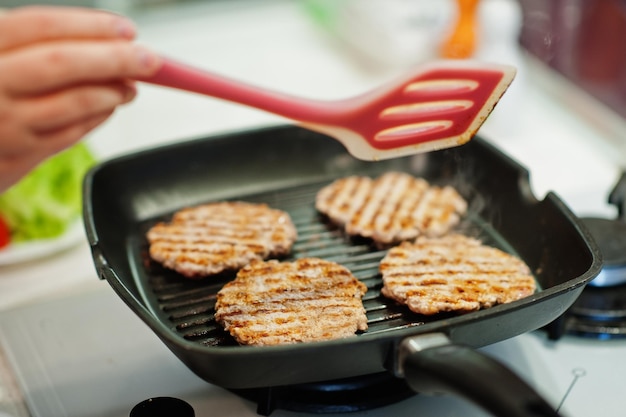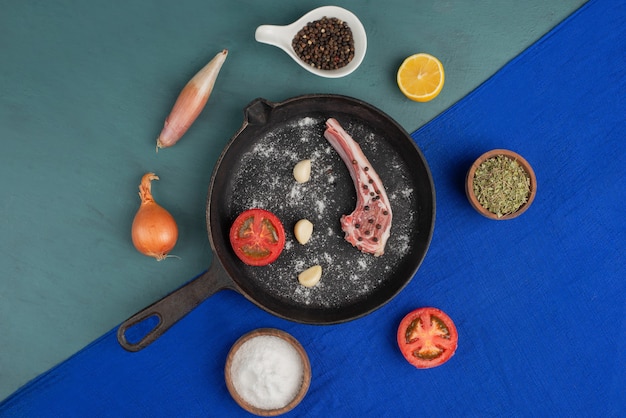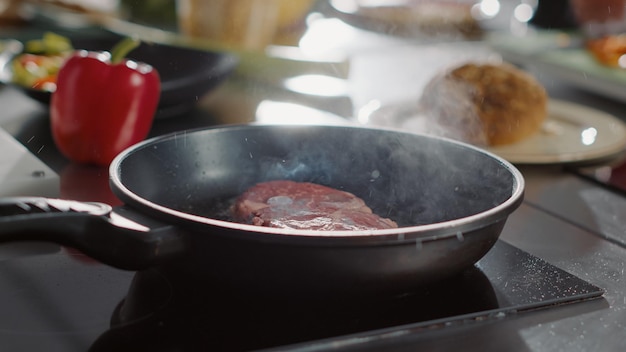We've all been there – that craving for a perfectly cooked steak, juicy and flavorful, that melts in your mouth and leaves you utterly satisfied. But sometimes, that perfect steak experience feels like a distant dream. You end up with something chewy, tough, or just plain bland. But don't despair! I'm here to share my secrets, the culmination of years of trial and error, for creating the pan-seared sirloin steak of your dreams.
This isn't just a recipe; it's a journey. It's about understanding the steak, knowing its quirks, and learning to coax out its full potential. I'll guide you through the entire process, from choosing the right cut to achieving that gorgeous sear, right down to the final resting time. So, grab a notebook, a glass of something refreshing, and get ready to elevate your steak game!
(Part 1) Choosing Your Champion

The first step on our steak journey is selecting the right cut. Now, I'm a huge fan of sirloin, primarily because it's widely available, reasonably priced, and offers a great balance of flavor and tenderness. But let's be real, there's no one-size-fits-all answer when it comes to steak. It ultimately boils down to your personal preference.
Some people adore the rich flavor of a ribeye, while others crave the leanness of a fillet. The key is to choose a cut that's thick enough to sear properly, aiming for about 1.5 inches for a truly satisfying steak.
Finding the Perfect Sirloin
When you're at the butcher's counter, look for a piece of sirloin that boasts a good marbling. This refers to the white streaks of fat running through the meat. Marbling adds flavor and keeps the steak moist during cooking. You want a nice, even distribution of fat, not just a few clumps here and there.
Also, make sure the sirloin has a vibrant red color, not too dark. Avoid any cuts that look dry or have any discolouration. A fresh, healthy cut will result in a more flavorful and tender steak.
(Part 2) Preparing the Battlefield

Alright, you've got your steak. Now, it's time to prepare for battle. This means prepping your tools, getting your ingredients ready, and setting the stage for a truly epic steak experience.
Gathering Your Arsenal
You'll need the following:
- A cast iron pan: This is my go-to for searing steak. It gets incredibly hot and distributes heat evenly, giving you that perfect sear. If you don't have a cast iron pan, a heavy-bottomed stainless steel pan will work well too.
- High heat oil: Olive oil works well, but you can also use grapeseed oil or avocado oil, which have higher smoke points. They're less likely to burn at the high temperatures needed for searing.
- Butter: The finishing touch for that extra layer of flavor and richness.
- Herbs and spices: A little salt, pepper, garlic powder, and maybe some fresh herbs like rosemary or thyme. Experiment with your favorites!
- A meat thermometer: Essential for ensuring your steak is cooked to your liking. Don't be intimidated, it's a simple tool that makes a big difference.
- A chopping board: For prepping your steak and other ingredients.
- Tongs: For safely flipping your steak and moving it around the pan.
Setting the Stage
Before you start cooking, make sure your pan is screaming hot. If it's not, the steak will stick, and you won't get that beautiful sear. Heat it over medium-high heat for about 5-10 minutes. You should be able to hold your hand a few inches above the pan and feel the heat radiating off of it.
(Part 3) The Art of the Sear

Alright, let's get to the heart of the matter. The sear is where the magic happens. This is where you create that delicious crust that adds so much flavor and texture to your steak.
Seasoning with Precision
Before you throw that steak into the hot pan, generously season it with salt and pepper. I like to use coarse salt and freshly ground black pepper, because they really enhance the flavor.
Don't be shy with the seasoning! You'll want to ensure the salt and pepper are evenly distributed across the surface of the steak.
The Critical Sear
Now, here's where things get exciting. Carefully place the steak in the screaming hot pan. Don't overcrowd the pan, as that will lower the temperature and prevent proper searing. If you have a large pan, you can cook two steaks at a time, but make sure they have plenty of space around them. The initial sear is crucial; let the steak sit undisturbed for about 2-3 minutes per side. Resist the urge to move it around too much. Let the steak develop a lovely crust before you flip it.
Creating Those Perfect Grill Marks
After those initial 2-3 minutes, you can rotate the steak 90 degrees, creating those beautiful crosshatch grill marks. This is all about aesthetics, but it also helps to cook the steak more evenly. You're aiming for a nice, deep brown crust on all sides.
Remember, the goal is to create a sear, not burn the steak. If you see the steak starting to blacken, quickly reduce the heat slightly. You want that beautiful dark color, but you don’t want to burn it.
(Part 4) The Finishing Touches
The steak is now beautifully seared and ready for the finishing touches. We're about to take things to the next level with flavor, tenderness, and that restaurant-quality vibe.
Butter Basted Bliss
Now, for that luxurious touch, add a knob of butter to the pan. As it melts, baste the steak with the buttery goodness, swirling the pan to distribute the flavor. You can also add a few sprigs of rosemary or thyme to the pan, letting them infuse their beautiful aroma into the butter.
The butter will add a richness and depth of flavor that you won't want to miss. Feel free to experiment with different herbs for a unique flavor profile.
The Art of Resting
Remember, the steak is still cooking even when it's out of the pan. To allow the juices to redistribute and prevent the steak from becoming dry, let it rest for 5-10 minutes. Cover it with a piece of foil, and let it relax in its own juices.
Resting is essential for a juicy and flavorful steak. It allows the muscle fibers to relax, allowing the juices to reabsorb into the meat, preventing them from escaping during slicing.
(Part 5) Getting the Temperature Right
So, you've seared your steak to perfection, let it rest, and now it's time to get that internal temperature just right. You're in charge here, so let's talk about how to cook your steak to your desired level of doneness.
Understanding Doneness
The perfect steak is all about personal preference. I personally enjoy my steak medium-rare, but there are different levels of doneness to choose from:
| Level of Doneness | Internal Temperature (°F) | Description |
|---|---|---|
| Rare | 125-130°F | Cool, red centre |
| Medium-Rare | 130-135°F | Warm, red centre |
| Medium | 135-140°F | Pink, slightly warm centre |
| Medium-Well | 140-145°F | Slightly pink centre |
| Well-Done | 145°F | No pink, brown throughout |
Using a Meat Thermometer
To ensure your steak is cooked to your liking, it's essential to use a meat thermometer. Insert the thermometer into the thickest part of the steak, avoiding bone or fat. You want to check the temperature in the centre of the steak.
If you're aiming for medium-rare, you're looking for an internal temperature of around 130-135°F. If you prefer your steak a little more cooked, adjust the temperature accordingly.
Using a meat thermometer is the most accurate way to determine the internal temperature of your steak. It eliminates guesswork and ensures a perfectly cooked steak every time.
(Part 6) The Finishing Touches: The Sauce and Sides
Your steak is perfectly cooked, resting, and looking incredibly tempting. Now it's time to add those final touches that will make your meal truly unforgettable.
The Sauce
For a simple yet delicious sauce, you can use the pan juices. Simply deglaze the pan with a little wine or broth, scraping up any caramelized bits stuck to the bottom. This will create a rich, flavorful sauce that perfectly complements your steak.
If you want something more elaborate, you can make a classic béarnaise sauce or a tangy chimichurri. But let's be real, sometimes simplicity is key. You can't go wrong with a classic steak sauce or a pinch of sea salt and fresh herbs.
Deglazing the pan is a simple technique that transforms the leftover bits in the pan into a flavorful sauce. It's a great way to add depth and richness to your steak.
The Sides
The perfect steak deserves equally delicious sides. Choose something that complements the flavours of the steak and offers a nice contrast in texture.
Here are a few ideas:
- Roasted vegetables: crispy asparagus, roasted brussels sprouts, or sweet potato fries are perfect for a hearty and flavorful side. The roasting process enhances the natural sweetness of the vegetables.
- mashed potatoes: A creamy classic that goes perfectly with steak. You can add garlic, herbs, or cheese for extra flavour. Mashed potatoes offer a comforting and familiar side to complement the steak.
- Salad: A fresh and light salad adds a welcome contrast to the richness of the steak. Try a simple green salad with a vinaigrette dressing, or a more substantial salad with roasted vegetables and a creamy dressing.
- Risotto: Creamy and flavorful, risotto adds a touch of elegance to your meal. Try a mushroom risotto or a parmesan risotto for a truly indulgent experience.
Experiment with different combinations of sides to find your perfect pairings. It's all about creating a balanced and delicious meal.
(Part 7) Enjoying the Fruits of Your Labour
Alright, the moment you've been waiting for is finally here! The steak is cooked to perfection, you've got your delicious sides, and you're ready to enjoy the fruits of your labour.
The Final Presentation
Slice the steak against the grain, creating beautiful, even slices. This will help to tenderize the steak and make it easier to eat.
Arrange the steak slices on a plate, drizzle with your chosen sauce, and arrange your sides around it.
If you're feeling fancy, add a sprig of fresh rosemary or a drizzle of olive oil for an extra touch of elegance.
The Moment of Truth
Now, take a moment to appreciate your creation. That beautiful crust, the juicy, pink centre, the aroma of the steak and sauce, it's all a testament to your hard work.
Take a bite, savour the flavour, and let the richness melt in your mouth.
You've done it. You've created the perfect pan-seared sirloin steak. Enjoy your culinary masterpiece!
(Part 8) FAQs
Here are some frequently asked questions about pan-seared sirloin steak:
1. Can I use a different type of pan?
While a cast iron pan is ideal for searing steak, you can use a heavy-bottomed stainless steel pan or a nonstick pan if you don't have one. However, cast iron pans are excellent at retaining heat, ensuring you get that perfect sear.
Remember, if you use a different pan, you may need to adjust the cooking time slightly, as the heat distribution may vary.
2. Can I cook steak without a thermometer?
You can, but it's not recommended, especially if you're a beginner. A thermometer is the most accurate way to ensure your steak is cooked to your liking.
However, if you don't have a thermometer, you can use the "touch test". Press the centre of the steak. If it's soft and jiggly, it's rare. If it's firm but still gives a little, it's medium-rare. If it's firm and bouncy, it's medium. This method is less precise than a thermometer, but it can be helpful if you're in a pinch.
3. Can I cook a thicker steak in a pan?
Yes, you can cook a thicker steak in a pan, but you may need to adjust the cooking time. It's best to use a meat thermometer to ensure the steak is cooked to your liking.
You may also want to consider using a combination of pan searing and oven cooking for a thicker steak. This ensures even cooking throughout.
4. What if I overcook my steak?
If you overcook your steak, it will be tough and dry. There's not much you can do to remedy this, so it's best to use a thermometer and avoid overcooking.
However, if you do happen to overcook your steak, you can try slicing it thinly and adding a flavorful sauce to help soften the texture.
5. Can I cook a steak in the oven?
Yes, you can cook a steak in the oven, but it's important to sear the steak first. This will create a delicious crust and help the steak cook evenly.
Preheat your oven to 400°F (200°C). Sear the steak in a hot pan for 2-3 minutes per side. Transfer the steak to a baking sheet and cook in the oven for 5-10 minutes, depending on the thickness of the steak.
Remember, a little patience and attention to detail can go a long way when it comes to cooking a perfect steak. Happy grilling!
Now that you've got all the tools and knowledge, go out there and conquer your steak game! Impress your friends and family with your newfound skills and enjoy every delicious bite of your pan-seared sirloin masterpiece.
Everyone is watching

How to Cook Frozen Lobster Tails Perfectly: A Step-by-Step Guide
RecipesLobster. Just the word conjures up images of lavish meals, special occasions, and a taste of luxury. But let's...

Pigs in a Blanket Cooking Time: How Long to Bake for Perfect Results
RecipesAh, pigs in a blanket. Just the name conjures up images of those delightful little parcels of crispy pastry en...

Pork Fillet Cooking Time: How Long to Cook It Perfectly
RecipesPork fillet, or tenderloin as it's sometimes called, is a real favourite in our house. It's so versatile, and...

The Ultimate Guide to Tender, Juicy Pulled Pork
RecipesRight, let's talk pulled pork. It's one of those dishes that just screams "comfort food," doesn't it? I mean...

The Ultimate Guide to Cooking Sweet Potatoes: From Roasting to Mashing
RecipesSweet potatoes. Just the name conjures up images of warm, comforting dishes, bursts of vibrant color, and a to...
